
The Miracle Piano Teaching System is educational software which uses a MIDI keyboard to teach how to play the piano. It was published in 1990 by The Software Toolworks for the Nintendo Entertainment System, Super NES, Macintosh, Amiga, Sega Genesis, and MS-DOS compatible operating systems.
The Print Shop is a basic desktop publishing software package originally published in 1984 by Broderbund. It was unique in that it provided libraries of clip art and templates through a simple interface to build signs, posters and banners with household dot-matrix printers. Over the years, the software has been updated to accommodate changing file formats and printer technologies.

Kid Pix is a bitmap drawing program designed for children. Originally created by Craig Hickman, it was first released for the Macintosh in 1989 and subsequently published in 1991 by Broderbund. Hickman was inspired to create Kid Pix after watching his son Ben struggle with MacPaint, and thus the main idea behind its development was to create a drawing program that would be very simple to use.

OutNumbered! is an educational video game published by The Learning Company in 1990 for both Windows and Macintosh PCs. It is aimed at children ages seven to fourteen and is designed to teach children mathematical computation and problem solving skills.

Star Wars: DroidWorks is a 1998 edutainment computer game and the premiere title from LucasArts subsidiary Lucas Learning. It uses the same engine as LucasArts' previous title Star Wars: Jedi Knight. The creators aimed to create a game that would be both appealing and nonviolent. The game's original release date was moved up by months, which resulted in the development team cutting some planned game features.
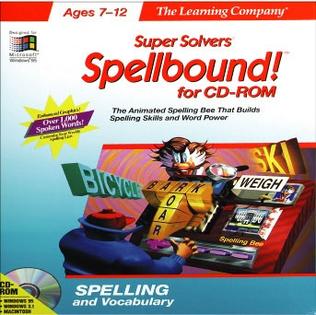
Spellbound! is an educational computer game made and distributed by The Learning Company aimed at teaching spelling, vocabulary, and language development to children ages 7 to 12 years. The objective of the game is to play spelling-related games to qualify and compete for successively higher bracket spelling bees, concluding with the player competing in the national spelling bee. The original game, released in 1991, was compatible with computers running DOS 3.3 or higher. A 1993 CD release added spoken dialogue and was compatible with Windows 95 and Macintosh.
McGee is a series of computer games released by Lawrence Productions for Kindergarteners ages 2–4.
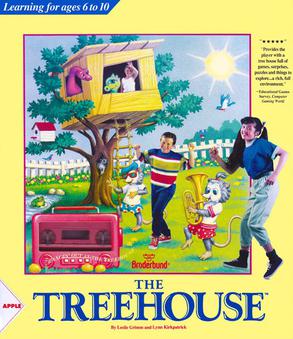
The Treehouse is an educational point-and-click personal computer game developed for DOS and then ported to Macintosh and the FM Towns, with Windows versions arriving later. Following the success of The Playroom, Broderbund created The Treehouse, which provides more content and furthers the user's ability to explore. First released in 1991, most copies were sold in educational supply stores rather than mainstream stores that sold computer software; it included a sing-along cassette tape. It was re-released in 1996 for Windows 3.1 and Windows 95. Although the Windows version has the same general activities, the characters, interface, and locations are different.
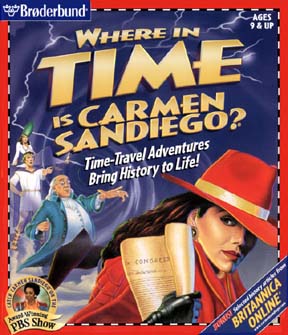
Carmen Sandiego's Great Chase Through Time is a 1997 edutainment point-and-click adventure game developed by Broderbund for Microsoft Windows and Macintosh devices. The game is a remake of the 1989 time-travel title Where in Time Is Carmen Sandiego?, making it the second Time video game in the Carmen Sandiego franchise. The game was strongly influenced by the short-lived PBS game show, Where in Time Is Carmen Sandiego?. The game was previewed at the 1997 Toy Fair in New York City. A demo version was included on the CD for Carmen Sandiego Word Detective and was available on the Carmen Sandiego website. After Broderbund was sold to The Learning Company, the game was re-released with the new title - Carmen Sandiego's Great Chase Through Time - but with minimal redesign.

Disney's Animated Storybook is a point-and-click adventure interactive storybook video game series based on Walt Disney feature animations and Pixar films that were released throughout the 1990s. They were published by Disney Interactive for personal computers for children ages four to eight years old. Starting from 1994, most of the entries in the series were developed by Media Station. They have the same plots as their respective films, though abridged due to the limited medium.

Disney's Activity Center is a series of PC and PlayStation games released by Disney Interactive with each title consisting of various activities and minigames to be completed, using aspects of their licensed property.
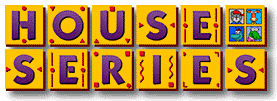
Early Learning House or simply the House Series is a collection of four main educational video games and two compilations for the Windows and Macintosh platforms, developed by Theatrix Interactive, Inc. and published by Edmark software. Each different game focuses on a particular major learning category with selectable skill settings for preschooler, kindergarten and elementary learners. Millie's Math House (1992) on mathematics, Bailey's Book House (1993) on language, Sammy's Science House (1994) on science, and Trudy's Time and Place House (1995) on history and geography. A spin-off, Stanley's Sticker Stories (1996), sees players create animated storybooks with the series' characters. Millie & Bailey Preschool and Millie & Bailey Kindergarten each contain the combined activities from two of the four software products. In addition the programs can be configured by an adult mode to suit students with special needs. Most of the activities in every game have two modes, one to allow learners to explore and try it out for themselves and the other for learners to follow specific tasks set by the game characters. Learners also have the option to print pictures of creative activities and record sounds in phonics activities. Later the games were re-developed by Houghton Mifflin Harcourt Learning Technology and re-published by The Learning Company with newer graphics and additional activities.

The Backyard is a video game created by Broderbund in 1993 for MS-DOS and Macintosh. It is a sequel to its predecessor The Playroom and the third game of the "Early Learning Family" series. It was designed for ages 3 to 6.
The Arthur video games franchise was a series of learning and interactive story video games based on the American-Canadian children's TV show Arthur. The games were released in the 1990s and 2000s for PlayStation and Windows and Mac OS computers.
Several video games based upon Blue's Clues, a children's educational television series by Nickelodeon, have been released, educational video games and web browser games based on the show. Most of the PC CD ROM-format titles were developed and published by Humongous Entertainment.

Reader Rabbit Toddler is a 1997 educational video game developed by KnowWare and published by The Learning Company. It is part of the Reader Rabbit series.

3-D Dinosaur Adventure is an educational video game by Knowledge Adventure released on CD-ROM for MS-DOS compatible operating systems in 1993. Versions for Macintosh and Windows 3.x were published in 1996. A 1997 re-release and an updated version for Macintosh and Microsoft Windows is titled 3-D Dinosaur Adventure: Anniversary Edition.
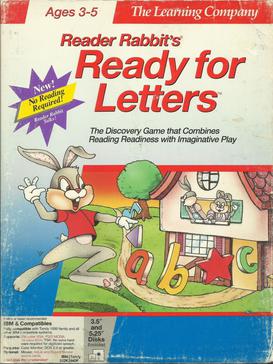
Reader Rabbit's Ready for Letters is a 1992 video game and the fifth game of the Reader Rabbit franchise. Although a spin-off title, it is designed for ages 3 to 6 to teach prereaders about becoming literate and phonics.
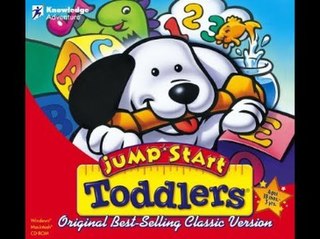
JumpStart Toddlers is a 1996 educational video game, the fourth within the JumpStart franchise. An enhanced version was released in 2000.
















